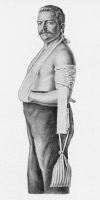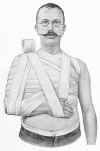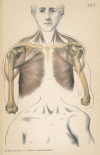Management of proximal humeral fractures in the nineteenth century: an historical review of preradiographic sources
- PMID: 21136221
- PMCID: PMC3048260
- DOI: 10.1007/s11999-010-1707-8
Management of proximal humeral fractures in the nineteenth century: an historical review of preradiographic sources
Abstract
Background: The diagnosis and treatment of fractures of the proximal humerus have troubled patients and medical practitioners since antiquity. Preradiographic diagnosis relied on surface anatomy, pain localization, crepitus, and impaired function. During the nineteenth century, a more thorough understanding of the pathoanatomy and pathophysiology of proximal humeral fractures was obtained, and new methods of reduction and bandaging were developed.
Questions/purposes: I reviewed nineteenth-century principles of (1) diagnosis, (2) classification, (3) reduction, (4) bandaging, and (5) concepts of displacement in fractures of the proximal humerus.
Methods: A narrative review of nineteenth-century surgical texts is presented. Sources were identified by searching bibliographic databases, orthopaedic sourcebooks, textbooks in medical history, and a subsequent hand search.
Results: Substantial progress in understanding fractures of the proximal humerus is found in nineteenth-century textbooks. A rational approach to understanding fractures of the proximal humerus was made possible by an appreciation of the underlying functional anatomy and subsequent pathoanatomy. Thus, new principles of diagnosis, pathoanatomic classifications, modified methods of reduction, functional bandaging, and advanced concepts of displacement were proposed, challenging the classic management adhered to for more than 2000 years.
Conclusions: The principles for modern pathoanatomic and pathophysiologic understanding of proximal humeral fractures and the principles for classification, nonsurgical treatment, and bandaging were established in the preradiographic era.
Figures











References
-
- Biographisches Lexikon der hervorragenden Ärzte aller Zeiten und Völker. Berlin, Germany: Urban & Schwarzenberg; 1934.
-
- Boileau P, Walch G. Shoulder arthroplasty for proximal humeral fractures: problems and solutions. In: Walch G, Boileau P, editors. Shoulder arthroplasty. New York, NY: Springer; 1999. pp. 297–314.
-
- Boyer A. The Lectures of Boyer, Upon Diseases of the Bones: Arranged into a Systematic Treatise by A. Richerand. Farrell M, trans. London, England: John Callow; 1807.
Publication types
MeSH terms
LinkOut - more resources
Full Text Sources
Medical

